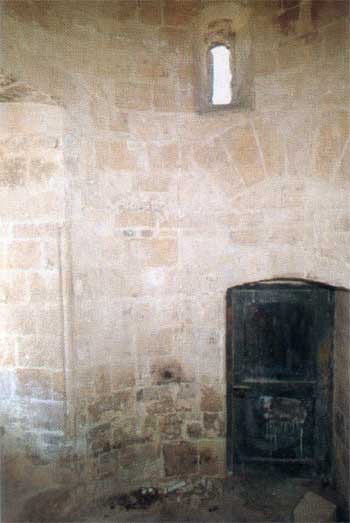word
tolo (Latin: tholus or tholum), meaning "a domed or gabled
building" (8), is not
without significance. Among the surviving early Knights' constructions
in Fort St. Angelo, the one that comes closest to this description
is the building with a fortified aspect and a circular internal
space, just outside the precincts of the church of St. Anne,
to the south.
This building was originally independent and
had a round-headed door with large voussoir-stones but, at an
unknown period, this was partially walled up and recut into
a square-headed shape. A slit-window in the blank face of the
masonry above provided the only source of light and ventilation
(9). The use and date of the
building has long excited speculation. Themistocles Zammit,
who investigated it in 1914, thought it was the tower of a windmill
(10). Architecturally it belongs
to a vernacular building typology that remained in use well
into the seventeenth century.
|
|
| Fort St. Angelo. Detail
of the circular interior space of the presumed tolo, or
strong room built by the Knights for the safekeeping of
the Rhodes treasure. It now forms part of the quarters
of the Knight Resident. Photo credit: The Marquis Cassar
de Sayn. |
|
It would therefore appear probable
that, unlike the other early Hospitaller buildings within the
precincts of the Fort, it was designed and built by Maltese
masons. The building was at an unknown time incorporated into
a barrack quarter and mutilated. It has now been restored and
refurbished to serve as part of the quarters of the Knight Resident.
A number of holy icons, including the miracle-working
Madonna of Phileremos, and some, at least, of the liturgical
furnishings, went to the church of San Lorenzo a Mare, on the
Birgu waterfront (11), that
the Knights used as a temporary conventual church. A fire, which
gutted the church in 1532, destroyed most of these treasures
but the Madonna of Phileremos escaped serious damage. The most
tragic loss were tapestries in silk and wool belonging to a
set commissioned in the Flanders, in 1493, by the Master Pierre
d'Aubusson, for the palace chapel on Rhodes. They represented
scenes from the lives of Sts Catherine of Alexandria and Mary
Magdalene. There are hints that some of the tapestries were
rescued and survived until around the end of the sixteenth century
(12), but nothing definite
is known.
A set of poorly preserved, and much restored
liturgical vestments in the collection of the Vittoriosa Collegiate
Chapter, might have been among the valuable items saved from
the fire. It consists of a chasuble, two dalmatics, and a cope,
and, is usually associated with the Pierre d'Aubusson bequest.
A shield charged with the arms of the donor quartered with the
Cross of Religion, is prominently displayed on the cope but
the poor state of preservation does not unfortunately allow
a reading although the quartering seems to imply a Master of
the Convent. The interest of the vestments lies in their embroidered
images, in silk and gold and silver thread, of Passion scenes,
episodes from the Life of the Virgin, and individual saints
standing in scalloped Gothic niches. They are of good quality
and suggest a fifteenth century French, or possibly Flemish,
manufacture. A better-preserved gold-cloth and embroidered silk
chasuble in the Museum of the |
|
[8] Du Cange,
Glossarium Medie ed Infimae Latinitatis, 1886, R-Z-, 7-8.
[9] It is possible, however, that the window was originally
one of a pair (its companion having been destroyed as a result of
stone replacement) which would explain why it is not centred with
the door.
[10] National Museum of Archaeology, Valletta, Field Notes
of Themistocles Zammit, Notebook 1, 93, 95.
[11] Birgu was honoured with the title of Città Vittoriosa
after the Great Siege of 1565. The name Vittoriosa by which the town
is now generally known, is here used for the post-1565 situation.
[12] A.T. Luttrell, op. cit., 14. |
|
